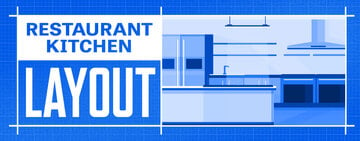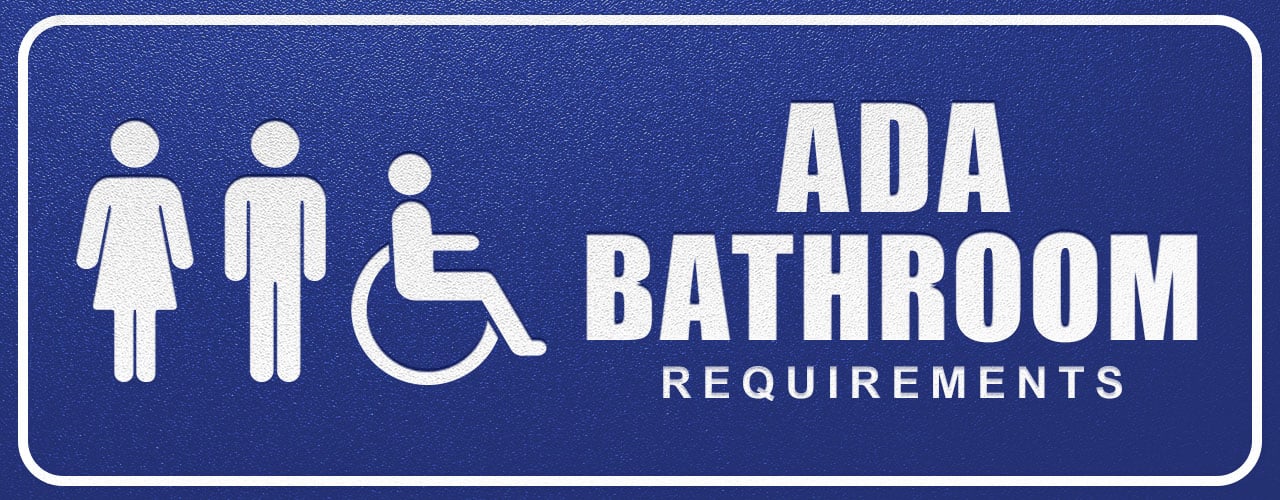
ADA Bathroom Requirements
Last updated on 1/9/2024ADA restroom requirements are an essential aspect to consider when designing or renovating a restaurant. These requirements are outlined by the Americans with Disabilities Act (ADA) and are aimed at ensuring that individuals with disabilities have equal access to facilities. ADA bathroom requirements cover various aspects such as the number and location of accessible restrooms, clear floor space, grab bars, sinks, and doorways. By adhering to ADA regulations, restaurants can provide a comfortable and inclusive dining experience for all patrons.
Shop All Handicap Bathroom Accessories
ADA Public Restroom Requirements
Before breaking ground on your new restaurant, it is important to consult your local jurisdiction to ensure that your plans are compliant with the ADA Standards for Accessible Design as well as compliant with state regulations. Below we highlight some of the most common areas of your restroom that would require additional consideration to bring them up to ADA regulations.
1. ADA Bathroom Layout
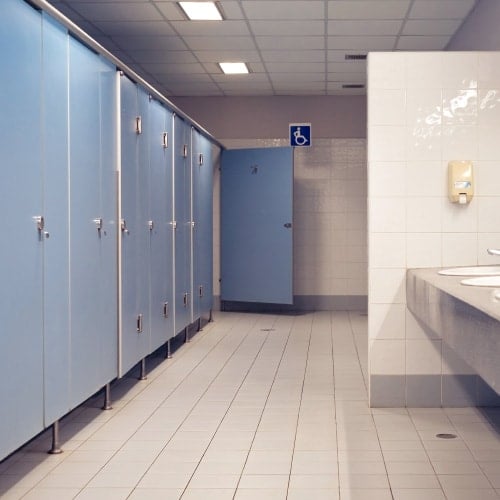
There are a few important aspects to consider when drawing up the floor plan and design of your bathroom. The following ADA bathroom layout details were made to allow access to customers using a standard 30” x 48” wheelchair.
- Handicap Signage - Customers should be able to easily locate the restroom and be able to identify if the restroom is handicap accessible, as indicated by handicap signs placed outside of the bathroom doors.
- Maneuvering Space - Disabled customers should be able to easily maneuver to the toilets and sinks within the bathroom or handicap stall. A 30” x 48” wheelchair requires either a circular diameter of 60” or a T-shaped turning space that is 60” in length with a 36” width.
- Mounting Heights - To make accessories such as dispensers and dryers accessible, their operable parts must be located no higher than 48” above the finished floor and no lower than 15”.
- Equipment Accessibility - Equipment and accessories in a handicapped bathroom or stall should be designed for a forward or parallel approach, as well as for both left- and right-hand access.
Large Bathroom Layouts
For a larger public bathroom, additional precautions should be taken to prevent congestion and challenges for disabled customers.
- Passageways - Entrances and exits should be lined up to allow for traffic in both directions. Bathroom aisles should allow for simple wheelchair turning and offer 67” of space between stall doors and lavatories. Passageways into the restroom must be a minimum of 48” wide.
- Accessories - Accessories like coat hooks and shelves should have a 30” x 48” clearing in front of them and be 40” - 48” above the finished floor to allow for easy access.
- Handicap Stalls - In a larger bathroom, there should be at least one 60” x 60” handicap stall. If there are 6 stalls or more, a 35” - 37” wide ambulatory accessible stall is also required.
2. ADA Stall Requirements
In an ADA compliant bathroom, certain requirements within the 60” x 60” handicap bathroom stall must be met. Use the following directions when designing your restroom stalls.
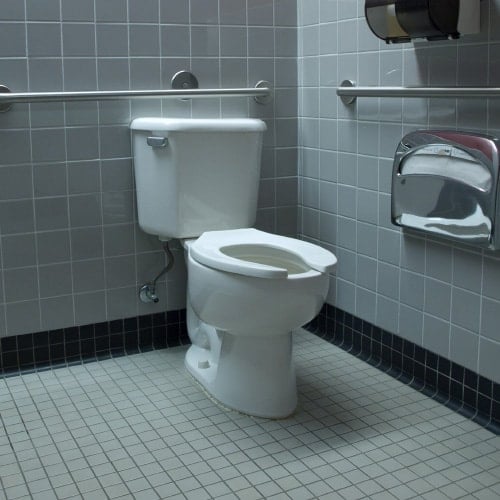
Doors
- Clearance - Doors must be out swinging, self-closing, and at least 36” wide to accommodate wheelchair-bound customers. If the door swings inward, there must be a 60” x 60” unobstructed maneuvering clearance within the stall.
- Handles - Door handles must be installed on both sides of the door, allowing for 1 1/2” knuckle clearance.
- Latches - Door latches must be easy to operate with one hand without pinching, twisting, or tightly grasping. They should be mounted between 34” - 48” inches above the finished floor.
- Weight - Doors should require less than 5 pounds of force to push or pull open.
Toilet
- Height - The seat of an ADA toilet should be installed at a height of 17” - 19” above the finished floor and 16” - 18” away from the sidewall to the centerline of the toilet.
- Lid - Toilet seat lids cannot be spring-loaded to return automatically to an upright position.
- Controls - Flush controls must be on the open side of the stall so customers do not need to reach around the bowl to access it.
- Clearance - Water closet clearances should have a depth of 56” for wall-hung toilets and 59” for floor-mounted toilets.
In-Stall Dispensers
- Distance - Toilet paper dispensers should be mounted so that the center of the dispenser is only 7” - 9” in front of the edge of the toilet bowl and unobstructed by the side bar.
- Height - The opening for the toilet paper dispenser should be 15” - 19” above the finished floor.
- Dispensing Features - For a handicapped stall, toilet paper dispensers that do not control or limit paper delivery are recommended to keep guests from needing to repeatedly reach for more paper.
- Cover Dispensers - Seat cover dispensers should be 15” - 48” above the finished floor.
Grab Bars
- Quantity - Handicap toilet stalls must have two horizontal grab bars, one on the rear wall above the toilet and the other on the side wall or partition closest to the toilet. A third 18” vertical grab bar may also be added above the grab bar on the side wall.
- Side Bar - The side wall grab bar must be between 42” - 54” long and located a maximum of 12” away from the rear wall.
- Rear Bar - The rear wall grab bar must be 36” long and located at a position that allows for 24” of the bar to extend past the centerline of the toilet in the direction of the open space of the stall.
- Height - Grab bars must be installed at a height of 33” - 36” above the finished floor and extend 1 1/2” away from the wall.
- Diameter - Grab bars must be rounded and smooth, and they should have a diameter of 1 1/4” - 2”. If they are square, they must have rounded edges and a 2” cross-section diameter (4” - 4 4/5” perimeter).
- Weight Capacity - ADA compliant grab bars must be securely anchored to the wall, be stationary in their brackets, and be able to support 250 lb. of force.
Urinals
- Height - The rim of an ADA compliant urinal must be a maximum of 17” above the finished floor.
- Depth - Urinals should have a minimum depth of 13 1/2” from the wall to the outer rim of the bowl.
- Flushing Mechanism - Flush controls must be at a maximum of 48” above the finished floor.
- Clearance - There should be a clear floor space of 30” x 48” in front of the urinal to allow for a forward approach.
3. ADA Lavatory Requirements
To encourage hand washing for proper hygiene, it’s important to consider handicapped bathroom requirements when designing your lavatory area within the restrooms of your business. The following are just some of the considerations for a handicap lavatory.
Sinks
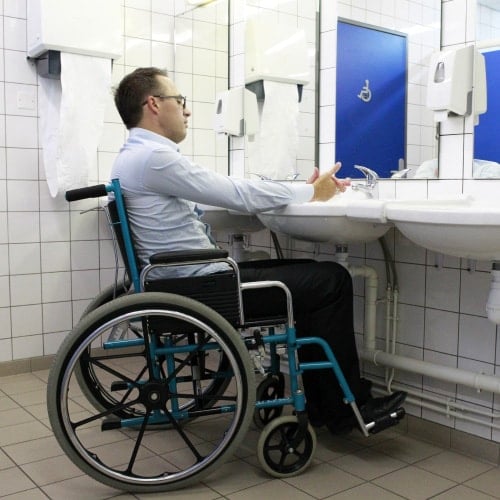
- Quantity - There should be at least one ADA compliant sink in the restroom.
- Clearance - Sinks must be installed with enough clearance underneath for a customer in a wheelchair to be able to reach the faucets. The sink basin should be a maximum of 34” above the finished floor, leaving a clearance of 27” high, 30” wide, and 17” - 25” deep.
- Toe and Knee Space - Toe space dimensions should be 9” in height and 6” in depth, followed by a knee space dimension of 27” in height and 11” in depth giving the sink user enough clearance to wash their hands without bumping any plumbing.
- Plumbing - Any exposed plumbing should be insulated and padded to prevent any injuries to customers’ legs. A protective panel can be installed to block off the plumbing but must still allow for 8” deep of knee clearance and 11” deep of toe clearance with a 9” height.
- Placement - Countertop sinks should be installed as close to the edge as possible to allow for easy access.
Faucets
- Ease of Use - Faucets must be easy to operate with one hand. Choose from lever-, push-, touch-operated, or electronically controlled faucets.
- Force - Faucets should only require a maximum of 5 lb. of force to operate and should not require twisting, pinching, or tight grasping.
- Depth - The reach depth to the faucet must not exceed 11”.
Soap Dispensers
- Height - Soap dispensers should be mounted at a maximum of 44” above the finished floor.
- Ease of Use - The soap dispenser and faucet should be able to be used simultaneously without interference.
- Accessibility - The reach depth to the soap dispenser must not exceed 11” and should only require a maximum of 5 lb. of force to operate.
Mirrors
- Edges - Mirrors should not have any exposed edges that may lead to injury.
- Height - The bottom edge of the reflective surface of a mirror located above a sink should measure 40” maximum above the finished floor. If the mirror is not above a sink or countertop, it should be located 35” above the finished floor.
- Full-length - A full-body mirror is recommended to provide the most inclusive experience.
Hand Drying
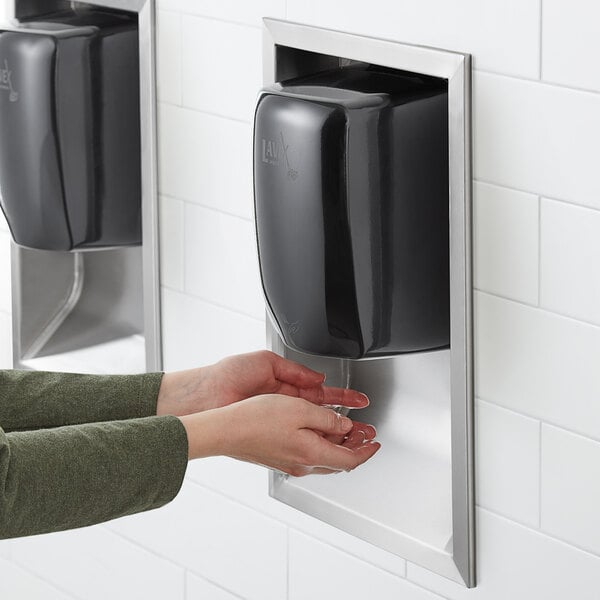
- Touch-free Drying - Touch-free or motion-activated electric hand dryers provide an easy-to-use alternative to paper towel dispensers. However, they cannot extend beyond 4” from the wall.
- Clearance - A clearing of 30” x 48” should be provided in front of the hand dryer to allow for a forward approach.
- Height - Hand dryers should be mounted between 40” - 48” above the finished floor.
- Orientation - Hand dryers and towel dispensers should allow for left-hand and right-hand approaches. If the unit does not allow for both, one of each type is recommended.
- Dispenser Opening - If using a paper towel dispenser, the opening should be at a maximum of 48” above the finished floor.
Trash Disposal
- Clearance - A trash receptacle on the floor can create a barrier or obstruction to wheelchair-bound customers. If used, floor trash cans should be out of pathways and not placed in front of sinks, hand dryers, or paper towel dispensers.
- Height - Recessed trash disposal units keep floors clear. They should not project more than 4” from the wall and should be mounted with the opening at 27” above the finished floor.
The Importance of ADA Compliance
Making these changes in your business may seem daunting, but it is important to understand the significance and impact ADA modifications can have. In 1990, the Americans with Disabilities Act was signed, making it a requirement for businesses to put in every effort possible to provide equal services to people with disabilities that are available to other customers. These services include the modification of entrances and exits, seating areas, and restrooms. These standards were updated in 2010 to account for innovations that improve accessibility. Companies that fail to meet ADA requirements may face serious penalties and fines.
You can refer to the U.S. Access Board’s guide to ADA accessibility standards along with the instruction of your local jurisdiction to make your restrooms accessible to a wider customer base, including:
- The disabled community
- People recovering from injuries
- Larger or heavy-set customers
- The elderly
- Parents with small children
Understanding ADA bathroom requirements is essential for commercial establishments to ensure accessibility and compliance with the law. These regulations cover various aspects, including toilet seat height, grab bar placement, sink height, and door maneuverability. By adhering to these guidelines, businesses can provide a safe and inclusive restroom environment for all individuals, regardless of their physical abilities. Taking the time to familiarize oneself with these requirements not only demonstrates a commitment to inclusivity but also helps avoid potential legal issues.


